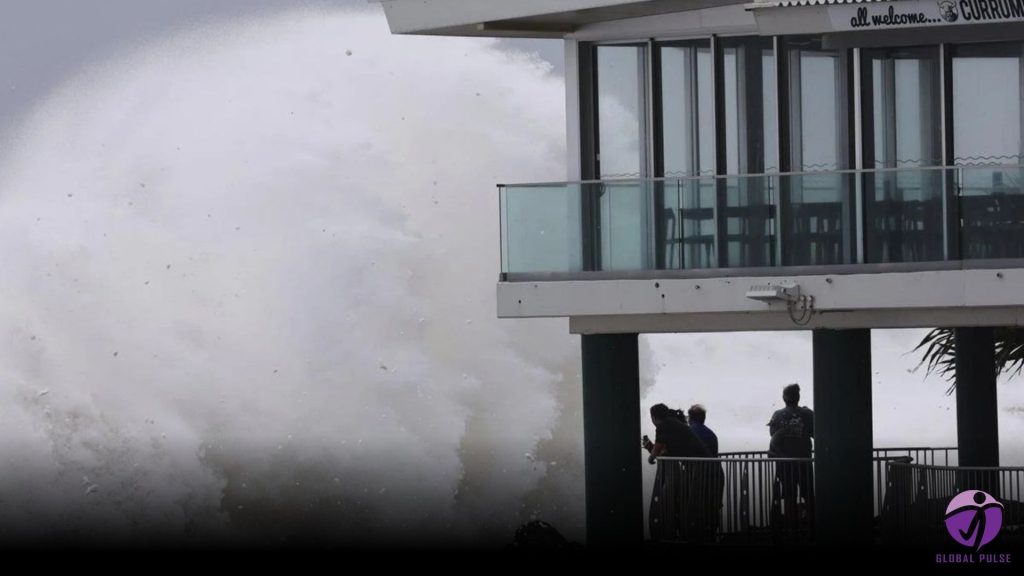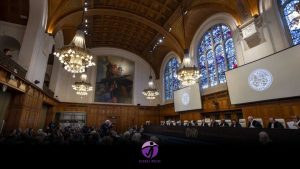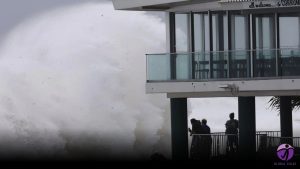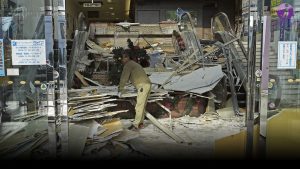Over 300,000 properties are currently experiencing power outages as a tropical storm approaches Australia’s east coast. The storm is bringing intense rainfall that is impacting the area.
Storm Alfred has officially been downgraded from a cyclone to a tropical low; however, local authorities caution that the danger it presents remains “not over.”
As the storm nears landfall, violent winds have begun to topple trees and power lines, resulting in flooded roads in low-lying regions. Alfred is expected to make landfall near Brisbane, with projections indicating it will continue to move inland later on Saturday.
Authorities have ordered the evacuation of tens of thousands of residents in the storm’s trajectory, while others are being advised to remain indoors for safety.
Four million residents in Queensland and northern New South Wales are in the path of an impending storm, as numerous weather warnings have been issued for both regions.
Emergency services have announced that they are collaborating with energy companies, as some residents have been informed they may face power outages lasting several days.
Energy provider Energex reported that approximately 287,000 customers in southeast Queensland are currently facing outages. Meanwhile, Essential Energy has indicated that over 42,600 homes and businesses in New South Wales have been affected by blackouts.
As they went to bed on Friday, residents of Brisbane, the capital of Queensland, prepared for a night of strong winds and heavy rainfall.
On Saturday morning, residents awoke to the news that the cyclone had been downgraded, indicating that the city would likely avoid the storm’s most severe impacts.
The threat remains significant in various regions of southeastern Queensland and northern New South Wales.
Prime Minister Anthony Albanese has warned that “the worst is yet to come” as the Gold Coast grapples with severe weather conditions that have persisted over the past few days.
Driving rain and strong winds are currently affecting the area. Power lines are down, and hundreds of trees have been uprooted in gardens, parks, and major roadways. Emergency services have cordoned off areas deemed most at risk, as significant debris remains scattered throughout the vicinity.
New South Wales state premier Chris Minns emphasized that the emergency is far from over, urging the public to recognize the situation’s “crucially important” nature and avoid “dismissing” the storm.
“The distinction between a tropical cyclone and a weather event is irrelevant to us,” he stated.
Stuart Fisher, the commander of the state’s emergency service operations, cautioned against complacency, emphasizing that authorities anticipate ongoing flooding in the region in the coming days.
With the storm approaching landfall, nearly 1,000 schools have been closed, public transport has been halted, and airports are currently shut down. In a significant development, elective surgeries have been canceled.
Flight operations are anticipated to remain suspended until at least Sunday.
In an exclusive report, the BBC engaged with multiple individuals from Brisbane’s homeless community who have sought shelter at Emmanuel City Mission, which is now operating as a 24-hour refuge.
A gum tree has fallen between two cabins at the Treasure Island Holiday Park on the Gold Coast, located just north of Surfer’s Paradise, causing damage to a third cabin. A boat was partially submerged in a canal just a block from the beach.
Access to the beach has become increasingly complex, as numerous pathways leading down to the shoreline are now obstructed. A sudden drop into the ocean reveals the relentless power of the waves, which have eroded the sand over time.
The clean-up operation will be delayed for several days due to the ongoing powerful winds and persistent driving rain.
As residents begin to assess the extent of damage, many choose to stay indoors for their safety.













